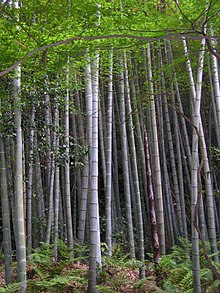**Taxonomy and Ecology:**
– Bamboo belongs to the subfamily Bambusoideae, with different tribes like Bambuseae, Olyreae, and Arundinarieae.
– Bamboo exhibits clumping and running growth patterns, spreading through root mass expansion or underground rhizomes.
– Growth rates can reach up to 910mm in 24 hours, influenced by climate and soil conditions.
**Geographic Distribution and Characteristics:**
– Native to warm and moist tropical regions, bamboo can also thrive in cool mountainous areas and highland cloud forests.
– Found in the Asia-Pacific region, the Americas, and some parts of sub-Saharan Africa.
– Bamboo is the largest grass family member, with culms up to 46 meters long and 36 centimeters thick, featuring hollow internodal regions.
**Economic and Cultural Significance:**
– Utilized in South and East Asia for construction and food, bamboo is also essential in arts and has a high strength-to-weight ratio for structures.
– Economically important for afforestation, carbon sequestration, and climate change mitigation.
– Compared to timber for its strength and versatility, bamboo plays a crucial role in various industries.
**Mass Flowering and Invasive Species:**
– Bamboo species rarely flower, with some flowering every 65-120 years, leading to plant decline.
– Some bamboo species are invasive, spreading through rhizomes, with examples like Golden Bamboo in the US.
– The mystery behind bamboo flowering and studies on invasive species are ongoing.
**Animal Diet and Cultivation:**
– Giant pandas, red pandas, bamboo lemurs, mountain gorillas, elephants, and chimpanzees feed on bamboo.
– Bamboo is used for livestock feed due to its high protein content.
– Bamboo farming is a $72 billion industry globally, known for its sustainability and carbon sequestration benefits.
Bamboos are a diverse group of mostly evergreen perennial flowering plants making up the subfamily Bambusoideae of the grass family Poaceae. Giant bamboos are the largest members of the grass family, in the case of Dendrocalamus sinicus individual culms reaching a length of 46 meters, up to 36 centimeters in thickness and a weight of up to 450 kilograms. The internodes of bamboos can also be of great length. Kinabaluchloa wrayi has internodes up to 2.5 meters in length. and Arthrostylidium schomburgkii with lower internodes up to 5 meters in length, exceeded in length only by papyrus. By contrast, the culms of the tiny bamboo Raddiella vanessiae of the savannas of French Guiana are only 10–20 millimeters in length by about two millimeters in width. The origin of the word "bamboo" is uncertain, but it probably comes from the Dutch or Portuguese language, which originally borrowed it from Malay or Kannada.
| Bamboo Temporal range: Early Eocene – Present
| |
|---|---|

| |
| Bamboo forest in Hunan, China | |
| Scientific classification | |
| Kingdom: | Plantae |
| Clade: | Tracheophytes |
| Clade: | Angiosperms |
| Clade: | Monocots |
| Clade: | Commelinids |
| Order: | Poales |
| Family: | Poaceae |
| Clade: | BOP clade |
| Subfamily: | Bambusoideae Luerss. |
| Tribes | |
| Diversity | |
| >1,462 (known species) species in 115 genera | |
| Synonyms | |
| Bamboo | |||||||||||||||||||||||||||
|---|---|---|---|---|---|---|---|---|---|---|---|---|---|---|---|---|---|---|---|---|---|---|---|---|---|---|---|
 "Bamboo" in ancient seal script (top) and regular script (bottom) Chinese characters | |||||||||||||||||||||||||||
| Chinese name | |||||||||||||||||||||||||||
| Chinese | 竹 | ||||||||||||||||||||||||||
| |||||||||||||||||||||||||||
| Vietnamese name | |||||||||||||||||||||||||||
| Vietnamese alphabet | tre | ||||||||||||||||||||||||||
| Chữ Nôm | 椥 | ||||||||||||||||||||||||||
| Korean name | |||||||||||||||||||||||||||
| Hangul | 대나무 | ||||||||||||||||||||||||||
| |||||||||||||||||||||||||||
| Japanese name | |||||||||||||||||||||||||||
| Kanji | 竹 | ||||||||||||||||||||||||||
| |||||||||||||||||||||||||||
In bamboo, as in other grasses, the internodal regions of the stem are usually hollow and the vascular bundles in the cross-section are scattered throughout the walls of the culm instead of in a cylindrical cambium layer between the bark (phloem) and the wood (xylem) as in dicots and conifers. The dicotyledonous woody xylem is also absent. The absence of secondary growth wood causes the stems of monocots, including the palms and large bamboos, to be columnar rather than tapering.
Bamboos include some of the fastest-growing plants in the world, due to a unique rhizome-dependent system. Certain species of bamboo can grow 91 centimetres (36 inches) within a 24-hour period, at a rate of almost 40 millimeters (1+1⁄2 in) an hour (equivalent to 1 mm every 90 seconds). Growth up to 120 centimeters (47.6 inches) in 24 hours has been observed in the instance of Japanese giant timber bamboo (Phyllostachys bambusoides). This rapid growth and tolerance for marginal land, make bamboo a good candidate for afforestation, carbon sequestration and climate change mitigation.
Bamboo is versatile and has notable economic and cultural significance in South Asia, Southeast Asia, and East Asia, being used for building materials, as a food source, and as a raw product, and depicted often in arts, such as in bamboo paintings and bambooworking. Bamboo, like wood, is a natural composite material with a high strength-to-weight ratio useful for structures. Bamboo's strength-to-weight ratio is similar to timber, and its strength is generally similar to a strong softwood or hardwood timber. Some bamboo species have displayed remarkable strength under test conditions. Bambusa tulda of Bangladesh and adjoining India has tested as high as 60,000 psi (400 MPa) in tensile strength. Other bamboo species make extraordinarily hard material. Bambusa tabacaria of China contains so much silica that it will make sparks when struck by an axe.
